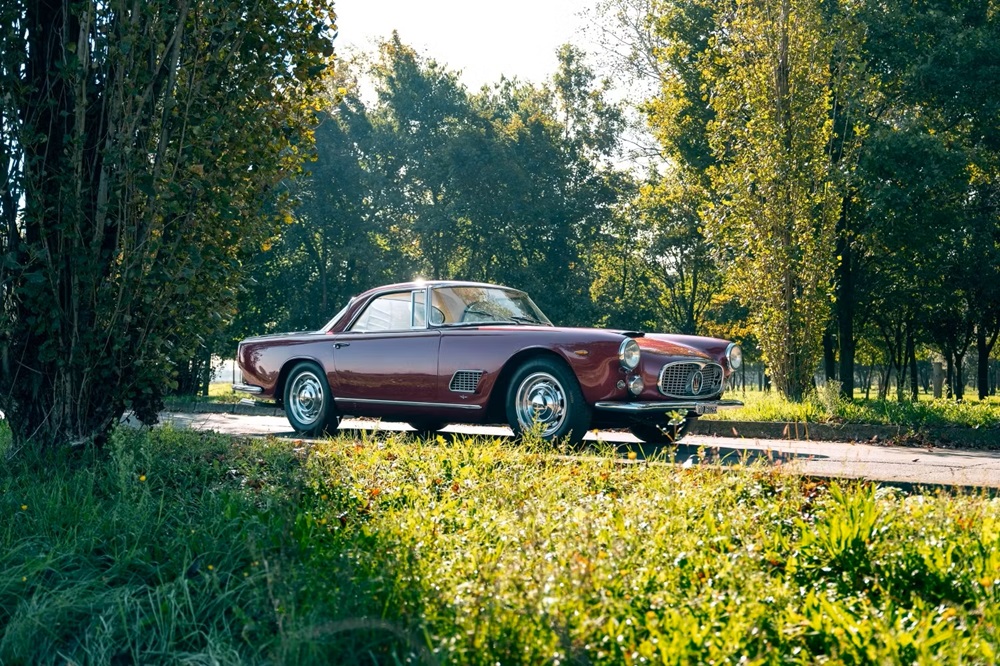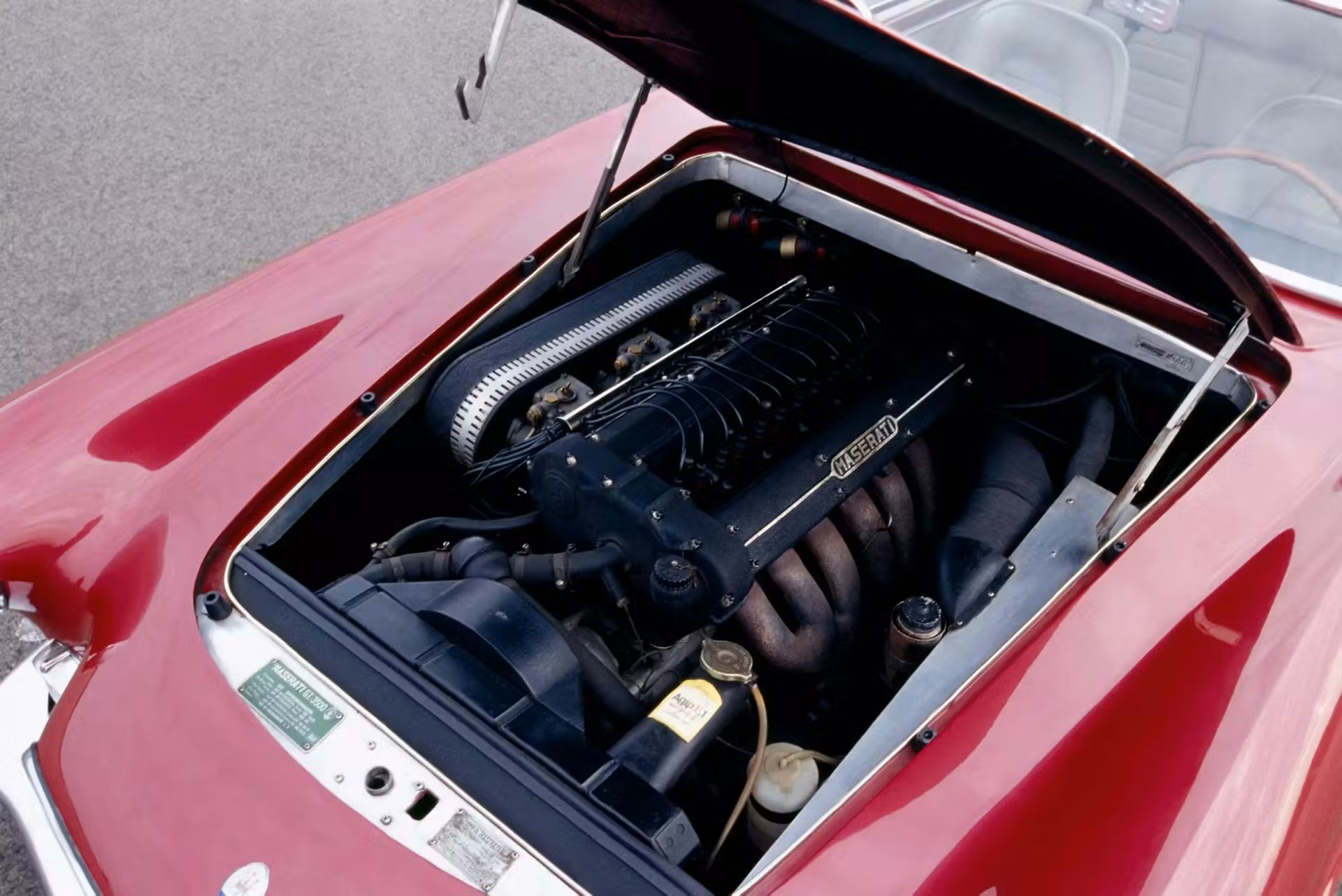What kind of classic car can just under 140 grand buy today? Surely not a rare, exotic Italian car that was one of the fastest gran turismos of the 1950s and ’60s, right?

Think again, and set your Google alerts for the 1957-64 Maserati 3500GT. With an average condition #3 (“good”) value of $139,000 in our price guide, the 3500GT might be the most undervalued “major” collector car of the moment. I struggle to think of another ride in its price bracket that comes remotely close to the 3500’s heady confluence of aesthetics, performance, gravitas, and usability. I’ll address each of those in turn, but consider this: $139,000 is just shy of our price guide’s $142,000 average value for an early Jaguar E-Type, and falls significantly short of the $192,000 average value for an early Porsche 911S. And those clog show fields like Hellcats at a street takeover.
There’s no clear reason for this relative undervaluation, either. The 3500 is from what is considered the greatest era for Maserati road cars, when the words “Citroën” and “Chrysler” had yet to be spoken in the company’s Modenese workshop. The late 1950s and early 1960s were Maserati’s halcyon days, with ownership under industrialist Adolfo Orsi prioritizing motorsports and competition to great success. Juan Manuel Fangio hustled a Maserati 250F to two of his Formula 1 driver’s championships, with half of the season in a trident-adorned car in 1954 and a full season in 1957.
The burgeoning World Sportscar Championship (WSC) coaxed some of history’s most evocative race cars from the greatest marques in the world, Maserati included. Under Orsi and engineer superstar Giulio Alfieri, Maserati claimed three second-place finishes in eight years of WSC competition.
This was all very exciting, and terribly expensive. Though the factory was busy with a healthy load of privateer race car orders, Orsi aggressively ramped-up investment in Maserati’s nascent road car division in the mid-1950s, which up to that point was a boutique operation. Production of its thoroughly hand-built A6s numbered not in the thousands or even the hundreds but in the dozens, and only to extraordinarily wealthy clientele.

So, the new-for-1957 3500GT became the firm’s first series production car, with Alfieri overseeing every aspect of the new grand tourer’s development. The engine was the centerpiece, with Alfieri drafting the 3.5-liter dual-overhead cam twin-plug aluminum inline-six directly from the 350S sports racer, changing only a few key parameters to detune the competition engine. A ZF-sourced four- or five-speed manual transmission did the shifting.
Early cars managed 217 hp and over 250 lb-ft, giving the 2800-ish pound 3500GT performance on-par with contemporary road-bound Ferrari 250s and Aston Martin DB4s. Carozzeria Touring’s signature Superleggera construction saw stunning aluminum coachwork draped over a tubular frame, complete with a leather-lined 2+2 cabin that matched the exterior for elegance. A steel-bodied, short-wheelbase droptop Spyder variant soon followed, now penned by Giovanni Michelotti during his time with Vignale. Maserati built over 2000 examples of the 3500GT in all, and proved to be a commercial success.

The list of players involved in creating it is quite the dossier of who’s-whos and what’s-whats of car history—and it’s all available for relative pennies. Again, it’s not like there’s some smoking tailpipe to be found here; talking to owners and collectors, there’s little reason these achingly gorgeous and wildly evocative grand tourers lag so significantly behind its contemporaries.
“It’s difficult to find a better value than a really good 3500GT,” says Matthew Ivanhoe. An avowed Maserati enthusiast, he’s seen some of the trident’s greatest cars cycle through both his garage and his Cultivated Collector dealer showroom in New Canaan, Connecticut. “The 3500GT is incredibly unique, wildly stylish, and embodies la dolce vida to the ‘nth’ degree.”

Every owner and expert I’ve spoken to describes the 3500 as wonderfully direct and exceedingly lovely to drive, with most drawing inevitable comparisons to similar thoroughbreds of the era from Ferrari and Aston Martin. “It’s more Aston Martin—this is the DB4’s Italian cousin,” laughs former 3500GT owner Eneuri Acosta. “Both use the same coachbuilder [Touring], Weber carbs, a six-cylinder engine, and a ZF five-speed transmission. And, if you look at the DB4 and the 3500, you see a lot of similarities. It’s just unavoidable.”

At the time of this writing, a bog-standard DB4 carries an average #3 value of $382,000—nearly three-times more than the Maserati—while the closest Ferrari analogs are the 250 GT Pinin Farina (PF) and 250 GT Boano, both averaging at just over $500,000. Naturally, the average value rarely tells the full story; excluding all-original survivors and older restorations, most concours-bound 3500GTs will fall between condition #2 (“excellent”) and condition #1 (“concours”), with perfect examples fetching from $225,000 – $235,000 and excellent cars from $160,000 – $195,000.
An equivalent condition #1 DB4 goes for over $700K, with $558,000 required on average for a condition #2 car. The 250 GT Boano raises the stakes to $735,000 and $605,000, respectively. And, if you have a landfill of cash to burn, a “project” (condition #4) Boano will set you back $450,000 to a ratty DB4’s $327,000.
A bum 3500GT? That’ll (initially) cost you an average of just $115,000. Or you could have a perfect one for less than the cost of either Ferrari or Aston.

Here’s the kicker—they’re getting even cheaper. This triumvirate of mid-century GTs appear to have only lost value ground during the white-hot pandemic market boom, with a steady decline for the 250 GT PF and DB4 since early 2019. Meanwhile, average values of a condition #2 3500GT peaked in early 2017 at $262,000, following a continual path of value stagnation and downward slide to its $170,000 current average (all years).
It’s widely accepted that the vintage Maserati market, on the whole, presents tremendous value for money—even when the conversation turns to seven-figure heavy hitters. A few theories have emerged—none conclusive—but I’ve got a favorite. Maserati’s history is tumultuous, to put it mildly, unravelling like an Italian melodrama that saw a number of unlikely (and unfortunate) owners, inconsistent reputation, a decade-long departure from the American market, and a current brand ethos wholly unlike what it was sixty years ago.
An argument could be made that in an alternate timeline where Maserati went bust after the early 1970s and thus unsaddled the trident from modern Maserati’s baggage, collector values might skyrocket in-turn. If an automaker proves enduringly popular, so too are its past products; see Porsche, Ferrari, and Lamborghini.
And yet…park a 3500 next to any of its contemporaries, and it blends in like a puzzle piece. I ask Ivanhoe if I’m missing something. Is it horrifically uncomfortable? Is it irrevocably unreliable? Is it a laughingstock at events?

This couldn’t be farther from the truth. “People have generally lost the plot as to what it means to have a good use-case for a car,” he says, thinking. “There’s been such a focus on modern and contemporary cars, because of perceived reliability and usability. I often observe that’s ultimately nullified by everyone’s obsession with [low] miles.”
“The discussion should really be regarding the impactful usage of a car, and the 3500GT is one of the single greatest values in that area,” he continues. “You can spend exceptional 3500GT money on a mediocre 964 Turbo [3.3] that gets you into exactly zero events, does nothing of any real consequence, and is not particularly unusual or unique. Meanwhile, the Maserati is a cheat code for events like the Colorado Grand.”
According to Ivanhoe, due to its relative rarity, a 3500GT is an event darling. While you’ll need an exceptional example to land a space on a major concours fairway, you’ll have your pick of any major American rallies like the California Mille and Copperstate 1000. Don’t be scared of racking up high-mileage—you’re not going to find yourself on the side of the road much, either. They’re robust cars, with an overbuilt, under-stressed engine backed by off-the-shelf componentry like a ZF transmission, Girling brakes, Salisbury rear-axle, Weber carbs, and Marelli ignition.

Like many 3500 owners, Acosta doesn’t shy from road trips. I met up with him a few years ago during Monterey Car Week, where his spectacularly original 3500GT ticked over in his rental garage, warm from the first half of what would be a 1000-mile road-trip. “It’s incredibly reliable. For being more than 60 years old, the engine and transmission have never been rebuilt. Just basic maintenance,” he says. “It was built to go 100 mph at 3900 rpm, cross continent. That’s where it sings, that’s where it feels best.”
“Every owner I talk to uses it for enthusiast events, and for a weekend driver. But, if you see another 3500GT at an event, that’s a lot—there’s just not that many around,” he explains. “It’s a thinking man’s car. It’s for someone who doesn’t want to be the flashiest, but has an appreciation for a really special handmade thing.”
Both Ivanhoe and Acosta mention conspicuous lack of 3500GTs on the event circuit. The same cannot be said for those Astons and Ferraris. Ivanhoe mentions you’ll need to step up to the 250 GT Boano/Ellena for improved eligibility, but the driving experience is markedly more agrarian when compared to the Maser. “The Maserati drives like a ‘60s car, while the Ferrari feels very much like it’s from the ‘50s.”

“They’re just so usable. We’re not talking about a Brass-era car, where you’re doing a backflip if you’re able to do 50-mph down a hill with a tailwind. We’re talking about a car that will cruise at a 110, 120 mph without breaking a sweat,” he explains. A few owners have reported long-distance fuel economy of up to 26 mpg—try that in a V-12 Ferrari.”
It’s not all twin-plug roses, however. Your first frustration will likely be finding the right car, a task Ivanhoe says you should take seriously. “Finding someone who has spent the time, money, and knows what a sorted car looks like is difficult,” he says. “A lot of cars claim to be [sorted], but are not. There is a fair bit of ‘lipstick on a pig,’ far more than you’ll find with Ferraris and Astons.”
A large portion of the 3500s you come across for sale are in average to below-average condition, thanks to a bit of a vicious feedback loop. These cars are easy to maintain, but tricky to fully restore, so it’s easy to get underwater on a project. Values, then, stay low due to a lack of really great cars—but the good ones pull their own value from the market floor, so the beat goes on.

The $532,000 (average) 3500GT Spyder throws all of this out the window—or does it? Just 242 Spyders were built—all mostly mechanically identical to the coupe—over the production run, making them a bit more common than the Ferrari and significantly more so than the DB4 cabriolet. Still, the respective values do not reflect the experience; while the 250 GT SII Cabriolet just outpaces the DB4 drop-top at $1.3 million against $1.15 million, the Maserati’s aforementioned $532,000 condition #2 average is nearly a third of the cost. And, while the Ferrari and Aston have stagnated, the Maser shows signs of value decline. Worth keeping an eye on, then.
As to which 3500GT to hunt, both Acosta and Ivanhoe agree the earlier, less-adorned cars hold slight priority. From purely an equipment perspective, wire wheels are a significant value-add that can boost the price tag by several thousand dollars. The same goes for power windows, air conditioning, and the later five-speed manual transmission. The Lucas mechanically fuel-injected GTi introduced in 1963 is modestly more powerful, but significantly more temperamental than cars equipped with the Webers, leading some owners to revert to carbs or to upgrade to modern EFI.
Regardless of spec, though, even an expensive 3500 is a seriously tempting value next to all of its period rivals, with very few pitfalls. And that’s worth celebrating, because there aren’t many deals quite like this left.
Report by Elliott Griffith
find more news here.










